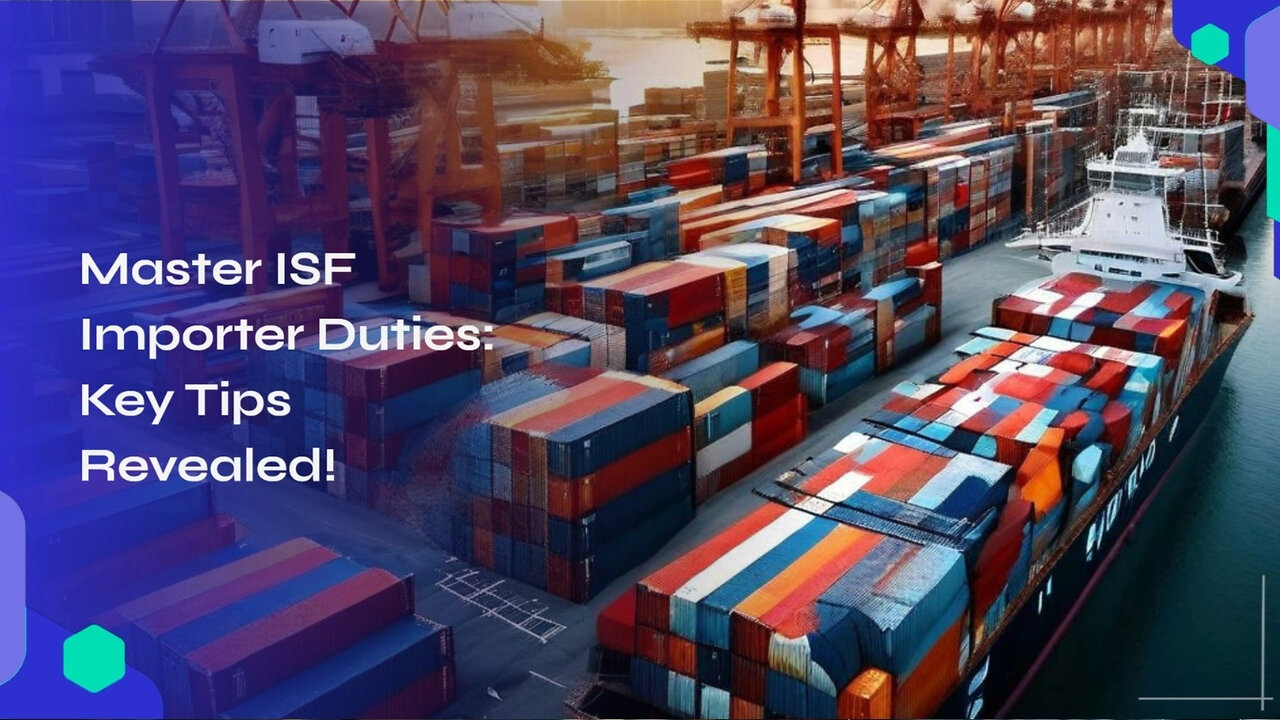Premium Only Content

Title: Mastering Your Role as an ISF Importer: Insider Tips and Best Practices
ISF Checklist || 805-970-7918 || contact@isfchecklist.com || www.isfchecklist.com
Title: Understanding Customs Valuation Methods in Brokerage: A Comprehensive Overview
Welcome, customs professionals! In this article, we will be diving deep into the concept of customs valuation methods and providing you with a comprehensive overview of the topic. So, let's get started!
Abstract:
Customs valuation is a critical aspect of customs brokerage that determines the value of imported goods for customs duties and taxes purposes. Understanding the various valuation methods is essential for customs brokers to accurately calculate duties and navigate compliance requirements. In this article, we will explore the six primary methods recognized by the World Trade Organization (WTO) under the Agreement on Customs Valuation (ACV). These methods include the transaction value method, transaction value of identical goods method, transaction value of similar goods method, deductive value method, computed value method, and fallback method. Additionally, we will discuss the key factors that influence customs valuation and provide practical tips for customs brokers to ensure compliance with valuation regulations.
1. Transaction Value Method:
The transaction value method is the primary method for customs valuation and is based on the price actually paid or payable for the imported goods. It considers all costs and charges incurred until the goods reach their destination in the importing country. However, certain adjustments may be necessary to determine the true transaction value, such as adjustments for royalties, assists, and commissions.
2. Transaction Value of Identical Goods Method:
This method is used when the imported goods being valued are identical or very similar to goods already imported. It allows customs brokers to use the transaction value of identical goods to determine the value of the goods being imported, provided that certain conditions are met.
3. Transaction Value of Similar Goods Method:
Similar to the previous method, this approach is used when identical goods are not available for comparison. In this case, the transaction value of similar goods is used as the basis for valuation, considering adjustments for differences between the imported goods and the similar goods.
4. Deductive Value Method:
The deductive value method involves determining the value of the imported goods by deducting the costs and charges associated with the sale of the goods in the importing country from the resale price. This method is suitable when the goods are sold in the importing country at a higher value than the imported price.
5. Computed Value Method:
In situations where the previous methods cannot be applied, the computed value method is used. This method requires customs brokers to determine the value of the goods based on the cost of production, profit and general expenses, and other relevant information.
6. Fallback Method:
The fallback method is used as a last resort when none of the previous methods can be applied. Under the fallback method, the customs value is determined based on reasonable means, such as the value of identical or similar goods, or expert opinions.
Factors Influencing Customs Valuation:
Several factors can impact customs valuation, including the terms of sale, discounts and allowances, royalties and license fees, packing and freight costs, and any other charges related to the importation.
Practical Tips for Customs Brokers:
1. Maintain comprehensive records of all transactions and related documents, including invoices, contracts, and shipping documents, to support the declared transaction value.
2. Stay updated with changes in customs regulations and valuation methods to ensure compliance.
3. Communicate effectively with importers to understand the intricacies of the transaction and identify potential adjustments necessary for accurate valuation.
4. Seek guidance from customs specialists or legal experts for complex valuation cases to ensure accuracy and compliance.
5. Conduct regular internal audits to review customs valuation practices and identify areas for improvement.
By grasping the nuances of customs valuation methods and considering the influencing factors, customs brokers can effectively calculate accurate customs duties and navigate compliance requirements. Adhering to these guidelines and tips will ensure a smooth customs brokerage process and minimize the risk of penalties or delays. Thank you for reading, and stay tuned for more in-depth discussions on customs brokerage topics!
#usimportbond #isfcustomsbroker #uscustomsclearing #isfentry
Video Disclaimer Here: This video is purely educational and has no ties with the US government.
00:19 - Understand the importance of Importer Security Filing (ISF) in international trade imposed by U.S. Customs and Border Protection (CBP).
00:49 - Follow key steps as an ISF importer including accurate filing, obtaining a Customs Bond, and partnering with a Customs Broker.
02:02 - Practical tips for excelling as an ISF importer include planning ahead, double-checking accuracy, and maintaining open communication with stakeholders.
03:13 - By following these tips and responsibilities, ISF importers can navigate the customs process with confidence and ensure successful importation.
-
 LIVE
LIVE
Scammer Payback
1 hour agoCalling Scammers Live
169 watching -
 1:01:07
1:01:07
In The Litter Box w/ Jewels & Catturd
22 hours agoVOX POPULI, VOX DEI | In the Litter Box w/ Jewels & Catturd – Ep. 709 – 12/19/2024
27.4K19 -
 22:54
22:54
Stephen Gardner
3 hours ago🔥JUST NOW: Trump JUST SHOCKED GOP with new DEMAND!!
10.9K23 -
 1:23:22
1:23:22
Tate Speech by Andrew Tate
4 hours agoEMERGENCY MEETING EPISODE 96 - LAWFARE BREAKDOWN
132K104 -
 16:53
16:53
DeVory Darkins
22 hours ago $11.04 earnedElon Musk Drops NIGHTMARE WARNING on Congress
25.7K124 -
 1:29:17
1:29:17
Mally_Mouse
3 hours agoLet's Play!! - Stardew Valley
15.2K1 -
 8:56
8:56
Melonie Mac
2 hours agoMy Superman Trailer Impressions
11.6K12 -
 LIVE
LIVE
StoneMountain64
4 hours ago☠️
232 watching -
 36:08
36:08
Standpoint with Gabe Groisman
4 hours agoEp. 62. Understanding the Chaos in Syria. Dr. Jonathan Schanzer
24.1K4 -
 3:52:39
3:52:39
Viss
4 hours ago🔴LIVE - Budget Zero To Hero Runs! - Delta Force
23.8K2